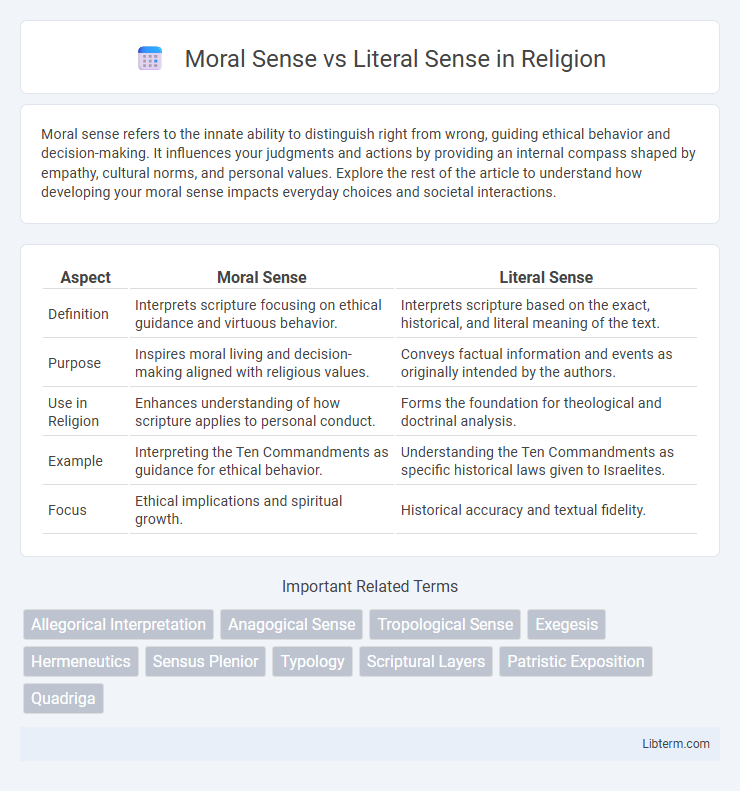Moral sense refers to the innate ability to distinguish right from wrong, guiding ethical behavior and decision-making. It influences your judgments and actions by providing an internal compass shaped by empathy, cultural norms, and personal values. Explore the rest of the article to understand how developing your moral sense impacts everyday choices and societal interactions.
Table of Comparison
| Aspect | Moral Sense | Literal Sense |
|---|---|---|
| Definition | Interprets scripture focusing on ethical guidance and virtuous behavior. | Interprets scripture based on the exact, historical, and literal meaning of the text. |
| Purpose | Inspires moral living and decision-making aligned with religious values. | Conveys factual information and events as originally intended by the authors. |
| Use in Religion | Enhances understanding of how scripture applies to personal conduct. | Forms the foundation for theological and doctrinal analysis. |
| Example | Interpreting the Ten Commandments as guidance for ethical behavior. | Understanding the Ten Commandments as specific historical laws given to Israelites. |
| Focus | Ethical implications and spiritual growth. | Historical accuracy and textual fidelity. |
Understanding Moral Sense and Literal Sense
The moral sense interprets biblical texts by emphasizing ethical lessons and guiding principles for righteous behavior, revealing deeper spiritual meanings beyond the surface. Literal sense refers to understanding the explicit meaning and historical context of scripture, focusing on the actual events and messages conveyed by the original authors. Distinguishing between these senses enhances comprehensive biblical interpretation, balancing concrete facts with moral insights.
Historical Background of Scriptural Interpretation
The distinction between Moral Sense and Literal Sense in scriptural interpretation traces back to early Christian exegesis, notably influenced by the works of Origen and Augustine, who developed multi-layered interpretive methods. The Literal Sense refers to the direct, historical meaning of the text, while the Moral Sense uncovers ethical teachings applicable to personal conduct. Medieval scholars further refined these categories, integrating them into the fourfold sense framework, solidifying their role in theological and ethical analysis of scripture.
Defining Moral Sense: Key Characteristics
Moral sense refers to the ability to discern right from wrong based on ethical principles and personal values, rather than literal or factual interpretation. It emphasizes understanding the underlying moral message or lesson conveyed in a narrative or action, rather than just the explicit content. Key characteristics include empathy, ethical reasoning, and sensitivity to societal norms that guide behavior and decision-making.
Exploring Literal Sense: Core Principles
The literal sense of a text refers to its primary, explicit meaning derived from the actual words and context, forming the foundation for all further interpretations. Core principles include understanding the historical context, author's intention, and the grammatical and syntactical structure to accurately capture what the text directly communicates. This approach ensures a grounded comprehension before applying moral or allegorical interpretations.
Differences Between Moral and Literal Senses
The moral sense interprets texts by uncovering ethical lessons and guiding principles for human behavior, emphasizing intentions and virtues beyond the explicit words. The literal sense focuses on the direct, historical, and factual meaning conveyed by the text's original language and context, providing the foundational understanding. Differences between moral and literal senses lie in their approach: moral sense seeks spiritual and ethical implications, while literal sense aims for concrete and precise comprehension of the narrative or message.
The Role of Context in Interpretation
Moral sense and literal sense interpretations rely heavily on context to convey accurate meaning in texts, especially in religious or literary works. The literal sense focuses on the explicit meaning of the words, while the moral sense seeks to uncover ethical lessons or principles applicable to human behavior, which requires understanding the cultural, historical, and situational background. Contextual factors such as author intent, audience, and genre critically shape how both senses are discerned and applied in interpretation.
Examples of Moral and Literal Readings
Moral sense interprets biblical texts to reveal ethical lessons and virtues, such as viewing the Parable of the Good Samaritan as a call to compassion and neighborly love. Literal sense focuses on the concrete meaning, understanding the same parable as a historical narrative about a man helped by a Samaritan while traveling. The distinction is vital in scripture study, where literal readings provide context and moral readings guide personal conduct and spiritual growth.
Impact on Religious Belief and Practice
Moral sense interpretation shapes religious belief by emphasizing ethical lessons and guiding adherents toward virtuous living, reinforcing moral conduct as central to faith practice. Literal sense focuses on the concrete, historical, or factual meaning of religious texts, grounding belief in tangible events and rituals that anchor communal worship and doctrinal consistency. Together, these interpretive approaches influence religious practice by balancing doctrinal authority with ethical application, impacting how faith communities internalize and enact spiritual teachings.
Contemporary Debates: Moral vs Literal Approaches
Contemporary debates between moral sense and literal sense approaches emphasize how interpretive frameworks influence ethical understanding and textual analysis. Moral sense interpretation prioritizes underlying ethical principles and values, while the literal sense insists on strict adherence to the text's explicit meaning. Scholars argue the balance between these methods impacts legal reasoning, theological exegesis, and moral philosophy, shaping both normative conclusions and practical applications.
Integrating Both Senses for Deeper Understanding
Integrating moral sense and literal sense enhances textual interpretation by combining ethical insights with the explicit meaning of the text. This approach enables readers to grasp underlying values and intentions, deepening comprehension beyond surface-level understanding. Employing both senses fosters a holistic analysis that enriches interpretation in literature, law, and theology.
Moral Sense Infographic

 libterm.com
libterm.com